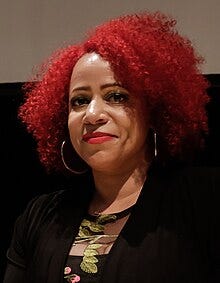When it comes to racial identification, we too often accept without question the One-Drop rule. The One-Drop rule arose during American slavery as a way to maintain binary distinctions between those considered black and those considered white in the eyes of the law and society. One black parent, grandparent, or even great grandparent rendered one a black American. No other self-identity was allowed. The One-Drop Rule The rule never worked in reverse. One white parent, grandparent, or great grandparent did not render one white. What was that all about?
Well, it was about keeping the white race pure. And also on top of the pecking order. Wikipedia tells me the One-Drop Rule has been dispatched to the dustbin of history in the famous Loving v. Virginia, 388 U.S. 1 (1967) U.S. Supreme Court opinion.
So, why do some (many - ?) black people continue to breathe life into a prejudiced and bigoted definition of black identity today? The History of the One-Drop Rule The One Drop Rule and Danielle Romero The One-Drop Rule Is In Effect Why do we insist that people who are 25% black or less are monoblack? Why are we blind to European admixture in those who are 75% black or more?
I believe we should reject the One-Drop Rule for several reasons.
First, the One-Drop Rule misperceives people of mixed-race. I am a big believer in perceiving the whole person, not a tiny sliver of someone. Consider the noted writer Nikole Hannah-Jones, author of the unfortunate 1619 Project. Hannah-Jones is the daughter of a white mom and a black American dad. Assuming her dad is a typical black American in genetic heritage, this combination would make make Hannah-Jones around 37% black DNA wise. Aren’t we denigrating 60% (if not more) of her ancestry when we refer to Hannah-Jones as black? Hannah-Jones is mixed-race, not a monoracial person.
Nikole Hannah-Jones
Second, we are no longer living in antebellum times. We should be unburdened by what has been, to quote a famous philosopher. We should not freeze frame black racial identity by a One-Drop Rule rooted in American slavery. Time has moved on. As a modern society, we should embrace the spectrum of trans racialism and reject the binary in racial classification.
Third, there is a nascent podcast movement among ambiguous black women to reject the One-Drop rule. These women refer to themselves as ambiguous Black Women or Exoticals. They embrace their blackness and their other identities. They are ambiguous upon first sight and lean into their ambiguity. I applaud this movement as a prologue to trans racialism. See this podcast link for Exoticals United. The Exoticals are living their whole racial truth, a truth more authentic than the One-Drop Rule.
Fourth, we must reject the One-Drop Rule in order to live in reality and not delusion. It is delusional to call someone white who self-identifies as black. Walter White. It is also offensive to call someone black who self-identifies as multi-racial or trans racial.
Walter White (1893 - 1955)
Finally, rejection of the One-Drop Rule affirms human dignity. Central to human dignity is the right of self-identification. The existence of one black grand parent or great grand parent is irrelevant to how one may define oneself. One can be ambiguous and be of many identities. One can be of Nigerian and English and Scottish and Irish and Southeast Asian and Native American antecedents at the same time, the very definition of an ambiguous black American woman. Consider this poignant message from a black American who no longer wants to be misperceived by others:
I have a few motivations for doing a deep dive into my family history this summer. First, throughout my entire life, people have always been fascinated by where I am from. I often get mistaken for being Ethiopian or Eritrean, and this year I've also been asked if I was Afro-Latina or from the Caribbean. I did my 23&Me a few years ago and I was really interested in what I saw. 51.2% Nigerian means both of my parents probably have some Nigerian lineage—I'm really curious what tribes/groups that may correspond to. 16.8% European seemed super high to me. I always assumed that came from my mom's side, which is why the sources tracing our lineage back to the 1500s in England are so cool. I assumed the Native American percentage would be higher (only 0.5%) because my mom used to talk to me about Carrie [ ] and Aunt Lorna on my grandfather's side and how strong their Native genes seemed to be. The report mentioned Indonesia, Myanmar, Thai, or Khmer also, which I'm assuming is from my dad's side because nothing like that was in Aunt [ ] DNA report. I was comparing the two trying to figure out which countries corresponded to each of my parents. And at the end, it mentioned recent ancestry in Jamaica (which I know is from my grandfather) and Grenada (which is from my father).
All of this information sparked a million questions in my head, and I decided I wanted to figure out as much as possible. When people ask me where I'm from, I want to have more information than just "on my mom's side we were enslaved in South Carolina and then moved to Brooklyn, and my dad's parents immigrated from Panama." I have always known more about my mom's side than my dad's side in general, so I have mainly been investigating my dad's side this summer, but I would love to know about both. I need to go to Panama and talk to my great-aunt Celine about my dad's family history, but I have discovered so far that my great-grandparents lived in Grenada and moved to Panama to work on the Canal. My grandmother came to the U.S. for work right before my dad was born.
I started putting together my own family tree on Ancestry.com so I can start putting together some of the pieces. My next step is to start interviewing my older relatives to get family stories, along with continuing to research. I'd love to one day be able to explain everything in my ancestry breakdown and know exactly who migrated from where and why I have that specific breakdown of countries, but I'll settle for finding out as much as I can.
Conclusion: The One-Drop Rule is of no value to this young woman. Her genetic self spans the country and the Western World and Sub-Saharan Africa. She is an attractive, ambiguous black American, the wave of our trans racial future.
Rashida Jones, An Ambiguous Black American Woman






